 |
|
 The
follow was written in 1995 and was included in
The Heiden Family
book which was distributed that year. I have added a
brief section on what has been happening since 1995 at the
bottom of the page. Comments from 2025 are in brackets [ ]. The
follow was written in 1995 and was included in
The Heiden Family
book which was distributed that year. I have added a
brief section on what has been happening since 1995 at the
bottom of the page. Comments from 2025 are in brackets [ ]. |
 |
 |

It started in the attic of Aunt Agnes Heiden's house
at
8700 South
Custer Road
and continued on a trail that led through East Germany by way of
Salt Lake City, Utah. Along the way, the search touched base in the
records of the National Archives in Washington D.C. and spent some
time with a genealogical researcher in California. Many hours
 of the
search were spent laboring in front of a microfilm reader (right) or
squinting at the screen of a computer. The search has led to renewed
contacts between relatives who had not been in contact with each
other for years. of the
search were spent laboring in front of a microfilm reader (right) or
squinting at the screen of a computer. The search has led to renewed
contacts between relatives who had not been in contact with each
other for years.
It has been a long search, stretching from 1972 through the mid-90's
and it is by no means completed. There is still a lot left to learn
about the Heiden Family. But, we have made a good start, and the
following is the story of where the search has led us and what we
have found out along the way.
|
 |
 |

In 1972, for some long forgotten reason, I
(Ralph Heiden) became interested in the
history of the Heiden family. I began to wonder where we came from
and how our family came to Monroe County, Michigan of all places.
At
that time, the oldest living relative that I knew was my father,
Arthur Heiden's,
Aunt Agnes (Brockman) Heiden who lived on South Custer Road. She was the wife
of my grandfather,
William Carl Heiden's, brother,
John. All of that generation of Heidens
were gone then except for Aunt Agnes who was 81 years old at the
time. One Saturday morning, my mother,
Mildred (Roggerman) Heiden, and I went to pay her a visit.
As we talked and I asked questions about the older generations of
Heidens, it became clear that she had many fond memories of the
family but, as is the case with most of us, her memory of the
specifics of dates and facts was a bit fuzzy. I asked if she might
have any old papers that could help us. She thought for a moment and
said, “Well, I think there is an old box or two up in the attic. I
haven’t looked at them in years.”
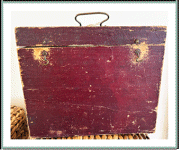 She went up to the attic and soon returned with an old reddish brown
wooden box with a hinged top and two latches on the side. It was
about a foot high and six inches wide. We slid the latches aside and
opened the box to discover a treasure of documents, papers and
receipts that would help tremendously in the search for the German
roots of the Heiden family. She went up to the attic and soon returned with an old reddish brown
wooden box with a hinged top and two latches on the side. It was
about a foot high and six inches wide. We slid the latches aside and
opened the box to discover a treasure of documents, papers and
receipts that would help tremendously in the search for the German
roots of the Heiden family.
In the box were many old, yellowing papers covered by nearly
illegible scratches in German script written with a fine point ink
pen. There were also official looking documents machine printed in
both German and English. Included were many hand written notes and
receipts for long forgotten transactions.
When Agnes saw my excitement at the discovery, she said, “You know,
I think I have some
old letters around here too. You might as well
have them if you are interested in all this stuff.”
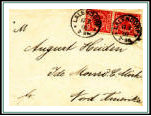 With that, she went into another room and, in a few minutes,
returned with a small cardboard box about 8 by 10 inches and an inch
deep. It was a sturdy box but looked well worn with age. I opened it
and discovered several envelopes addressed in that same old German
script lettering. One was addressed, “Mastr Heinrich un Ernst Heiden
in Monerow, bei Chicago, Staaten Michigan, Nord-Amerika.” Many
others had been sent to “Frau Ww. August Heiden, Monroe-Mich, Nord-Amerika.” With that, she went into another room and, in a few minutes,
returned with a small cardboard box about 8 by 10 inches and an inch
deep. It was a sturdy box but looked well worn with age. I opened it
and discovered several envelopes addressed in that same old German
script lettering. One was addressed, “Mastr Heinrich un Ernst Heiden
in Monerow, bei Chicago, Staaten Michigan, Nord-Amerika.” Many
others had been sent to “Frau Ww. August Heiden, Monroe-Mich, Nord-Amerika.”
From the envelopes, it appeared that most had been sent by
someone named
Marie Dohmstrich while others were also signed by an
Emilie Dahme. They
were mailed from
Rostock, Germany over a period of several years in
the 1920's. Inside the envelopes were letters also written in a
flowing script handwriting that was totally unintelligible to me. I
had no idea who these people were or why they were writing to my
great-grandparents but I knew I wanted to find out.
In the bigger box there were many documents that provided much
needed information. Included were three very old looking pages, each
of which had a red wax seal affixed near the bottom next to a
signature. They were each dated April 22, 1873 and were signed by an
official in the German town of
Klaber. From what I could make out,
these were documents from the home province of my great grandfather,
August Heiden, that may have have had something to do with
proof of
citizenship.
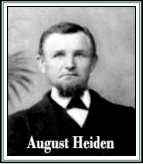 One page was for August Friederich Anton Theodor Heiden son of Maria
Heiden from the village of Gr. Wokern. He was born January 27, 1838
and baptized on February 4th of that year. The second document
concerned Elisabeth Sophie Wilhelmine Friederike Adolphine Knaack,
August’s wife who was born November 3, 1841 and baptized November
14th. The last page dealt with Meta Friederike Henrietta Elisabeth
Heiden, their daughter, who was born on December 23, 1870 and
baptized January 8, 1871. Two sons, Heinrich and Ernst also came
with their parents from Germany but their documents were not in the
box. One page was for August Friederich Anton Theodor Heiden son of Maria
Heiden from the village of Gr. Wokern. He was born January 27, 1838
and baptized on February 4th of that year. The second document
concerned Elisabeth Sophie Wilhelmine Friederike Adolphine Knaack,
August’s wife who was born November 3, 1841 and baptized November
14th. The last page dealt with Meta Friederike Henrietta Elisabeth
Heiden, their daughter, who was born on December 23, 1870 and
baptized January 8, 1871. Two sons, Heinrich and Ernst also came
with their parents from Germany but their documents were not in the
box.
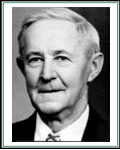 These papers presented a bit of a mystery. I knew my grandfather,
William Carl Heiden
(right), had two brothers,
Heinrich and
Ernest
(Ernst), but who was
Meta? To my knowledge, there
had been no mention of
an adult woman named Meta in the family. There was an old story,
however, about a child who had died at sea on the voyage from
Germany. Was that story true? Could this be her? Little did I know
that it would be over 20 years before I would finally learn the fate
of Meta Heiden. These papers presented a bit of a mystery. I knew my grandfather,
William Carl Heiden
(right), had two brothers,
Heinrich and
Ernest
(Ernst), but who was
Meta? To my knowledge, there
had been no mention of
an adult woman named Meta in the family. There was an old story,
however, about a child who had died at sea on the voyage from
Germany. Was that story true? Could this be her? Little did I know
that it would be over 20 years before I would finally learn the fate
of Meta Heiden.
These documents were where I began to see the
names of
Gross Wokern,
Klaber, Güstrow,
Mamerow, Neinhagen,
Ribnitz-Damgarten and
Teterow, the small German villages and towns
were our ancestors lived. Discovering these names was extremely
valuable for conducting further research into the German Heidens
during the 18th and 19th centuries.
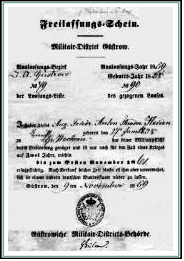 Another paper prominently displayed the word, “Militair” which, even
with a minimal understanding of German, led me to think of a
military discharge. It was issued in the Güstrow District and had
August’s name on it and two dates, November 9, 1859 and November,
1861. Another paper prominently displayed the word, “Militair” which, even
with a minimal understanding of German, led me to think of a
military discharge. It was issued in the Güstrow District and had
August’s name on it and two dates, November 9, 1859 and November,
1861.
There were documents written in English too. One was August Heiden’s
application for U.S. citizenship which was sworn to on April 4,
1879. His Certificate of Naturalization was there too. August was
granted citizenship on November 2, 1896 at the Court House in
Monroe, Michigan.
Also included in the box were several mortgages for different farms,
property tax receipts for the late 1800's and miscellaneous receipts
for lumber, clothing and other items. I have all the original
documents stored in protective covers. Copies and translations of
most of them are included in later chapters of this report.
|
 |
|
 |

Since so
many of the Heidens had been members of the
St
Matthew Lutheran Church, I decided to see if there were any
records there that might help. In 1964, St Matthew had
joined with St. Mark’s church and was now called
Prince
of Peace so I sent a letter to them asking for help.
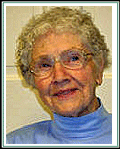 It
happened that Madelyn (Hanson) Berns
(right), the wife of my cousin,
Walter, was working as church secretary at the time. She
was also doing some genealogy work so she pulled
together a list of names and dates pertaining to
relatives who had been members of the church over the
years. This helped greatly in moving forward in the
search. It
happened that Madelyn (Hanson) Berns
(right), the wife of my cousin,
Walter, was working as church secretary at the time. She
was also doing some genealogy work so she pulled
together a list of names and dates pertaining to
relatives who had been members of the church over the
years. This helped greatly in moving forward in the
search.
|
 |
|
 |
|
 My next step was to
try to determine the exact date when August Heiden and family landed
in the United States. I now figured that they left Germany shortly
after being issued documents in April, 1873 and I knew that my
grandfather, Wm Carl Heiden, had been born in Michigan on April 1, 1874. My next step was to
try to determine the exact date when August Heiden and family landed
in the United States. I now figured that they left Germany shortly
after being issued documents in April, 1873 and I knew that my
grandfather, Wm Carl Heiden, had been born in Michigan on April 1, 1874.
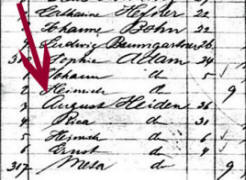 So, I
contacted a professional genealogical researcher in Washington, D.C.
who searched the National Archives for the appropriate ship's
passenger list. The records she found showed that August and his
family arrived at the port in New York City aboard the German
freighter,
Saxonia, on June 4, 1873. So, I
contacted a professional genealogical researcher in Washington, D.C.
who searched the National Archives for the appropriate ship's
passenger list. The records she found showed that August and his
family arrived at the port in New York City aboard the German
freighter,
Saxonia, on June 4, 1873.
It listed August Heiden, his wife, Rika, and their three
children, Heinrich age 6, Ernst who was 4 and a child, Meta, 9
months of age. Reportedly, one infant died during the voyage but the
researcher could not find a record of its name. |
 |
 |
|
To
continue the search, I turned to the Church of Jesus
Christ of the Latter Day Saints (LDS), also known as the
Mormons. This religion was started in the mid-1800's
and, it is my understanding, that they believe that
ancestors who lived before that time can be baptized
posthumously as Mormons. That is one reason why they are
so heavily involved in genealogy.
 In order
to help their members do their research, the church has
gone throughout the world gathering all sorts of
historical records and placing them onto microfilm. They
store the films in a giant vault in Salt Lake City, Utah
and distribute them to local churches for use by both
members and non-Mormons. In order
to help their members do their research, the church has
gone throughout the world gathering all sorts of
historical records and placing them onto microfilm. They
store the films in a giant vault in Salt Lake City, Utah
and distribute them to local churches for use by both
members and non-Mormons.
In the mid-70's, I went to the
local LDS church in East Lansing, searched their extensive
indexes and discovered that they had films of old church
records for the tiny parishes of
Gross Wokern and
Klaber
which were August and Friedericka's home villages. The
films covered the years from 1650 to 1860 but they were
hand written and were often unreadable or confusing to
the untrained (and strained) eyes.
These
records confirmed much of what I already knew from other
sources. This substantiation from a second source helps
lend credibility to the information. Scouring these
films also resulted in the compilation of a huge list of
names of related and unrelated individuals leading back
to about 1785. Because of the poor quality of many of
the films and my lack of extensive background in the
German language, it was very difficult to keep track of
everyone. I looked at the pages of names and decided I
needed to find some help.
[In 1993, I flew to Salt Lake
City and did some onsite research in their massive archives.
This was before very much had been digitized so it was mostly
viewing microfilms and books]
|
|
 |
|
 |
|
  Somewhere, I obtained an address for a
genealogical center in Leipzig in what was then called East Germany.
On a whim, I sent them a letter
requesting
further information. I had no idea whether they would answer my
request. The year was 1973 and we were still in the middle of the
“Cold War” and this was an Eastern Bloc country after all. Somewhere, I obtained an address for a
genealogical center in Leipzig in what was then called East Germany.
On a whim, I sent them a letter
requesting
further information. I had no idea whether they would answer my
request. The year was 1973 and we were still in the middle of the
“Cold War” and this was an Eastern Bloc country after all.
But, I thought I would give it a
try and much to my surprise, I received a rather detailed
response. This new information also confirmed parts of what I
had already discovered and it provided plenty of new information
too. |
|
 |
|
 |
|
For about
10 years, my job and other demands took me away from
working on the genealogy. Whenever I would see my aunts
or uncles, they would often ask, “What are you doing
with that family history?” I would always answer that I
was “working on it” and would have something done soon.
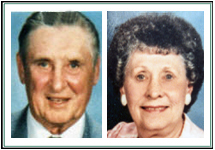 In 1985,
the family had a gathering at
William Frank
and Helen
(Henning) Heiden’s (right)
house and I put together a summary of what I had
discovered about the family to that point in a letter. In 1985,
the family had a gathering at
William Frank
and Helen
(Henning) Heiden’s (right)
house and I put together a summary of what I had
discovered about the family to that point in a letter.
The brief
summary that was distributed ended with the paragraph,
“These records did, however, confirm what I had learned
earlier and resulted in the compilation of endless lists
of related individuals leading back to about 1785.
Unfortunately, from what I could translate and
understand of the German, it appears that we come from a
long line of sturdy farm workers and house servants.
Sorry! No royalty or even a horse thief in our past (at
least as far as I could tell).”
|
|
 |
 |
|
In late 1994, I
finally made the commitment to complete the family history and get
it out to people before Christmas of 1995. The first thing I did was
purchase a computer program called Reunion ® to help me organize all
the data and keep the different generations and hundreds of
individuals straight. I know have almost a thousand people entered
representing over 700 different families (not all are from the Heiden family, however).
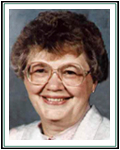 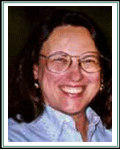 I was also aware that at least two
other people had been working for a long time gathering information
on the Heidens. I contacted Mary Lou (Heiden) Opfermann (left) (one of my
godparents), daughter of Leo Heiden, and found that she too was
using a computer program to keep track of data. She sent me a
diskette with her information and I added it to mine. I was also aware that at least two
other people had been working for a long time gathering information
on the Heidens. I contacted Mary Lou (Heiden) Opfermann (left) (one of my
godparents), daughter of Leo Heiden, and found that she too was
using a computer program to keep track of data. She sent me a
diskette with her information and I added it to mine.
Karen (Berns) Wheaton, Walter Berns’
(right) daughter, had also been pulling
together information. I visited her and found several
new facts to add to my database. She had quite a bit of
information about Mary (Rambow) Heiden’s family, the
Rambows.
|
 |
|
 |
|
For a couple of years,
I have been using the computer network called Prodigy ®. It has a
Genealogy Bulletin Board where people can ask questions and get help
on their research. I asked for help in translating German documents
and a couple of native speaking Germans on the network responded
with translations. Several of the translations covered later in this
report are from people on the Prodigy network.
 One person
said that he had a book that showed a picture of many of
the ships that brought people to America from Germany
during the 1800's. Since I knew that our family came
over on the
Saxonia, I asked him to look it up. He did
and sent me a copy of a drawing that shows this ship. One person
said that he had a book that showed a picture of many of
the ships that brought people to America from Germany
during the 1800's. Since I knew that our family came
over on the
Saxonia, I asked him to look it up. He did
and sent me a copy of a drawing that shows this ship.
Perhaps
the most important discovery I made on Prodigy was of a
man named, Robert Albert from California. He was doing
research on families from the little German towns in
Mecklenburg close to were our ancestors lived. We agreed
on a fee and he got the appropriate microfilms from Salt
Lake City and continued the search for me. He was able
to confirm the information that I had found twenty years
earlier and then traced the Heidens back even further in
history until the records became unreadable. details
of what he found are covered in Chapter II.
[Of course Prodigy is long gone
as far as I know.]
|
|
 |
|
 |
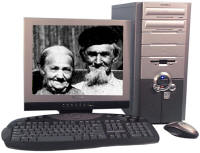
My computer program [in 1995]
will print a sheet which contains all the information on a
particular person with blank spaces where something is missing. I
organized these sheets by family groups and sent them to about 75
different families in the spring of 1995. I received nearly 70
responses which is fantastic for this type of venture.
With these
questionnaires, I not only requested facts, I also asked
people to jot down their
memories about William Carl and Mary (Rambow) Heiden.
The responses were amazing as people recounted stories
and little anecdotes that showed the great impact of
these two people on so many lives.
I also met
with several family members to get their memories
directly or to check on certain stories or details that
came up in the writing of this document. I met and
tape-recorded meetings with many relatives and also with
Pastor Don F. Thomas of the
Prince of Peace Lutheran
Church. Transcripts of these wide ranging discussions
are included in Chapter IV also.
 Finally,
as the time for printing pressed close, I turned to
several relatives including Mary Lou (Heiden) Opfermann,
Dianne (Heiden) Houpt, Karen (Berns) Wheaton and
her sister, Margie Berns for help with
layout, proof reading and cross checking facts. This
book is the result of the good will and efforts of many,
many wonderful people in the Heiden family. Finally,
as the time for printing pressed close, I turned to
several relatives including Mary Lou (Heiden) Opfermann,
Dianne (Heiden) Houpt, Karen (Berns) Wheaton and
her sister, Margie Berns for help with
layout, proof reading and cross checking facts. This
book is the result of the good will and efforts of many,
many wonderful people in the Heiden family.
Thanks to you all!
[This was the end of the section
that appeared in the 1995 The Heiden Family Book.]
|
|
 |
|
 |
|
 The
Heiden Family 1995 was extremely successful for a family
history. We have such a large family that over 130 copies were
distributed. I was 47 at that time and I am now a few months
away from my 77th birthday. Like everyone, a lot things, mostly
good but some not so good, have occupied my time so the family
genealogy was on the back burner for much of span of three
decades. The
Heiden Family 1995 was extremely successful for a family
history. We have such a large family that over 130 copies were
distributed. I was 47 at that time and I am now a few months
away from my 77th birthday. Like everyone, a lot things, mostly
good but some not so good, have occupied my time so the family
genealogy was on the back burner for much of span of three
decades.
I began creating websites way
back in the 1990s as part of my job as a horticulturist for
Michigan State University. So, it seemed natural to put the
family information in that format. In the printed version, we
were only able to include a few dozen photographs or actual
copies of documents. So one of the first major tasks was to turn
paper photos and documents into digital format. Including
duplicates, I have around 6,000 digital files in .jpg or .gif
format created mostly by scanning the originals.
About 20 years ago, I created a
simple website and put it on some DVDs (remember those?) for my
brothers and sisters. Then I got busy with other stuff and put
genealogy on the back burner.
 A few years ago, we moved to New
Jersey and I rediscovered the boxes of family pictures and
papers which reignited my interest. I bought the software,
RootsMagic, found the old files from my previous software,
Reunion. Fortunately, everything converted from one program to
the other and I didn't need to re-enter any data. A few years ago, we moved to New
Jersey and I rediscovered the boxes of family pictures and
papers which reignited my interest. I bought the software,
RootsMagic, found the old files from my previous software,
Reunion. Fortunately, everything converted from one program to
the other and I didn't need to re-enter any data.
I bought a membership to
Ancestry.com, started building the website and here we are
today.
|
 |
|

